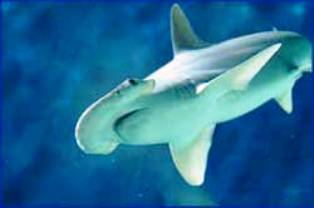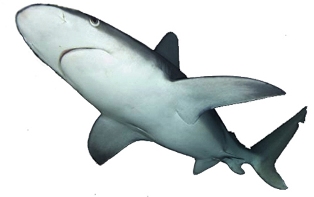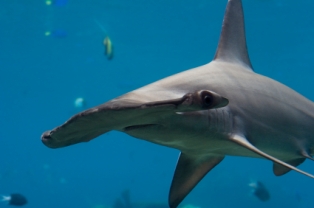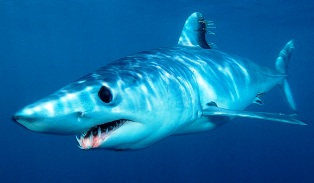Sometimes called a Brown
Shark because of its brownish color, the Sandbar Shark has a massive set
of teeth that are triangular, serrated and razor sharp. It is one of the
biggest coastal sharks in the world, and is closely related to the dusky
shark, the bignose shark, and the bull shark. Its dorsal fin is
triangular and very high, and weighs as much as 18% of the shark's whole
body. Sandbar sharks usually have heavy-set bodies and rounded snouts
that are shorter than the average shark's snout. Their upper teeth have
broadly uneven cusps with sharp edges. Its second dorsal fin and anal
fin are close to the same height. Sandbar sharks can grow to about 7
feet long. Female sandbar sharks can live as long as 21 years and males
can live to 15 years. The sandbar shark is both a predator and a
scavenger; feeding chiefly near the bottom on fish and shellfish. The
sandbar shark migrates long distances, in the western Atlantic
they range from Massachusetts to Brazil. The sandbar shark, true to its
nickname, is commonly found over muddy or sandy bottoms in shallow
coastal waters such as bays, estuaries, harbors, or the mouths of
rivers, but it also swims in deeper waters.
The scalloped hammerhead
shark belongs to the large hammerhead species, and like all
representatives of this family, has the typically formed "hammer"
consisting of a central dent and an arched front edge (hence the name).
Another typical characteristic is the free end tip of the second dorsal
fin which almost reaches the tail fin. Their coloring is mainly olive,
bronze or light brown with a white belly. The edges of the fins are
usually darker on young animals but becomes lighter as they grow older.
Mature females can reach a length of more than 4 meters, the average
length is, however, less. This hammerhead species feeds mostly on
fish such as sardines, herring and mackerels, occasionally also on
invertebrates such as octopuses. Large scalloped hammerhead sharks also
eat small-sized shark species such as the Atlantic sharpnose shark.
Scalloped hammerhead sharks are found practically around the world in
the coastal regions of tropical, subtropical and moderate climate zones.
The shortfin mako shark is a sleek spindle
shaped shark with a long conical snout. This shark has short pectoral
fins and a crescent shaped caudal (tail) fin. There is a distinct caudal
keel on the caudal base. Its second dorsal fin is much smaller than the
first. The teeth are are slender and slightly curved with no lateral
cusps, and are visible even when the mouth is closed. There is marked
counter shading on this shark: dorsally it is a metallic indigo blue
while ventrally it is white. The shortfin mako can grow to lengths of
3.9 meters (13 feet). There is still some uncertainty about its
life-span, but it is suspected to reach ages of between 11-23 years. As
one of the fastest sharks in the ocean, this powerful shark can attain
burst swimming speeds of up to 22 mph and can leap clear of the water to
heights of up to 20 feet. These qualities have made this species a
sought after sport fish in some parts of its range.
The shortfin mako feeds mainly upon bony fishes including mackerels,
tunas, bonitos and swordfish, but may also eat other sharks, porpoises
and sea turtles. Shortfin mako sharks live in tropical and temperate
offshore waters




No comments:
Post a Comment